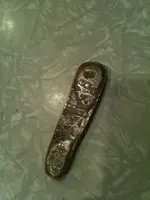I doubt that the object in question is a fake, mostly because of the circumstances of it's discovery.
Unless the owner wants to sell it, then I see no reason to spend money having it scientifically analyzed.
If however he does want to have it authenticated/valued, then It presumably will take an expert numismatist to do so.
As far as the value goes, that depends on how much provenance can be deciphered from the markings and how much a collector or museum is willing to pay.
Checking the gold content is an easy task and is very non invasive.
Any jeweler or numismatist can do it for free or very cheaply, or he can even do it himself.
http://www.goldtestsolutions.com/?gclid=CJ_LqI2UjKECFcN05Qod4SWvNg
Assaying is a whole other matter.
Assaying Gold (fire assay)
The gold is melted down and stirred, by which a complete mixture is effected, so that an assay piece may be taken from any part of the bar after it is cast. The piece taken for this purpose is rolled out for the convenience of cutting. It is then taken to an assay balance (sensible to the ten-thousandth of a half gram or less), and from it is weighed a half gram, which is the normal assay weight for gold, being about 7.7 grains troy. This weight is stamped 1000; and all the lesser weights (afterwards brought into requisition) are decimal divisions of this weight, down to one ten-thousandth part.
Silver is next weighed out for the quartation (alloying), and as the assay piece, if standard, should contain 900-thousandths of gold, there must be three times this weight, or 2700-thousandths of silver; and this is the quantity used. The lead used for the cupellation is kept prepared in thin sheets, cut in square pieces, which should each weigh about ten times as much as the gold under assay. The lead is now rolled into the form of a hollow cone; and into this are introduced the assay gold and the quartation silver, when the lead is closed around them and pressed into a ball. The furnace having been properly heated, and the cupels placed in it and brought to the same temperature, the leaden ball, with its contents, is put into a cupel (a small cup made of burned bones, capable of absorbing base metals), the furnace closed, and the operation allowed to proceed, until all agitation is ceased to be observed in the melted metal, and its surface has become bright. This is an indication that the whole of the base metals have been converted into oxides, and absorbed by the cupel.
The cupellation being thus finished, the metal is allowed to cool slowly, and the disc or button which it forms is taken from the cupel. The button is then flattened by a hammer; is annealed by bringing it to a red heat; is laminated by passing it between the rollers; is again annealed; and is rolled loosely into a spiral or coil called a cornet. It is now ready for the process of quartation. This was formerly effected in a glass matrass, and that mode is still used occasionally, when there are few assays. But a great improvement, first introduced into this country by the Assayer in 1867, was the--"platinum apparatus," invented in England. It consists of a platinum vessel in which to boil the nitric acid, which is to dissolve out the silver, and a small tray containing a set of platinum thimbles with fine slits in the bottom. In these the silver is taken out, by successive supplies of nitric acid, without any decanting as in the case of glass vessels. The cornets are also annealed in the thimbles; in fact there is no shifting from the coiling to the final weighing, which determines the fineness of the original sample by proportionate weights in thousandths. In this process extra care has to be taken in adding the proportion of silver, as the "shaking" of any one cornet, might damage the others.
Assaying Silver
The process of assaying silver differs from that of gold. To obtain the assay sample, a little of the metals is dipped from the pot and poured quickly into water, producing a granulation, from portions of which that needed for assay is taken. In the case of silver alloyed with copper there is separation, to a greater or less degree, between the two metals in the act of solidification. Thus an ingot or bar, cooled in a mould, or any single piece cut from either, though really 900-thousandths line on the average, will show such variations, according to the place of cutting, as might exceed the limits allowed by law. But the sudden chill produced by throwing the liquid metal into water, yields a granulation of entirely homogeneous mixture that the same fineness results, whether by assaying a single granule, or part of one, or a number.
From this sample the weight of 1115 thousandths is taken; this is dissolved in a glass bottle with nitric acid. The standard solution of salt is introduced and chloride of silver is the result, which contains of the metallic silver 1000 parts; this is repeated until the addition of the salt water shows but a faint trace of chloride below the upper surface of the liquid. For instance: if three measures of the decimal solution have been used with effect, the result will show that the 1115 parts of the piece contained 1003 of pure silver; and thus the proportion of pure silver in the whole alloyed metal is ascertained. Extensive knowledge and experience are required in such matters as making the bone-ash cupels, fine proof gold and silver, testing acids, and other special examinations and operations.
GG~











 You lucky ,,,,,,
You lucky ,,,,,,